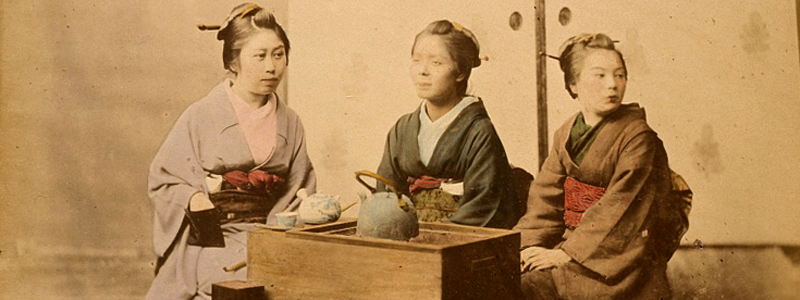
A Brief History of Tea
When was the first cup brewed?

Here is a short timeline of some noteable dates in the history of tea. Over the centuries, tea has gradually gained in popularity. How important will it be in the next century?
2737 BC
According to legend Chinese Emperor Shen Nung discovers tea when some leaves
from a nearby bush fall into his pot of boiling water. (Water was commonly
boiled at this time before drinking.) Rather than discard the water, he
sipped it and found that it invigorated him.
206 BC- 220 AD
During the Han Dynasty, tea
becomes a major commodity for the first time.
59 BC
Wang Bao wrote the first known book with instructions on buying and preparing tea.
220 AD
Famed physician and surgeon Hua Tuo wrote Shin Lun, in which he describes tea's ability to improve mental functions.
1191
A Japanese monk named Eisai brings tea seeds to Kyoto and plants
Japans first tea bushes.
1500s
The Japanese tea ceremony begins to develop under the guidance
of Zen monk Sen-no Rikyu
1600
British East India Company granted a charter by Queen Elizabeth
I.
1602
Dutch East India Company established.
1610
The first shipment of Chinese tea, Fujian grown Tong mu Phoenix
Lapsang, reaches Holland. News of the exotic new beverage
begins to spread throughout European society.
1630s
Tea appreciation begins among the elite of Paris. It is believed
that the practice of adding milk to tea was developed in France
by a noblewoman, Madame de la Sablière.
1652-1654
Tea introduced to England by the Dutch. The new beverage
comes to be touted as one of the worlds first health
products and is recommended by the government as a replacement
for Ale, then the traditional breakfast beverage.
1679
Londons tea auction begins selling its first lots of Chinese
tea.
1713
East India Company's tea sales reach 97,000kg for the year.
1773
Boston Tea Party. Chests of tea are thrown into Boston Harbor
to protest against a newly imposed tax on tea by Britain.
1813
East India Company's tea sales grow to 14.5 million kgs per annum. These
large numbers may be attributed to the fact that the company holds
a monopoly on British tea imports from China.
1823
Robert Bruce, a Scot, learns of wild tea growing in Assam and reports
his find to East India Headquarters in London. (Until this
time the British Empire had yet to produce her own tea in large
quantities)
1838
First lot of Assam tea sails for London. This lot of 12 chests
fetches high prices at auction. Chinas monopoly on
world production begins to diminish.
1841
Tea is first planted in Darjeeling by a British surgeon working
in the area.
1860s
James Taylor establishes Ceylons first tea factory.
Late 1800's
Cultivation and trading of Rooibos begins in South Africa.
1903
The silk teabag makes its debut. Purists everywhere sigh.
Note:
the first teabags were made of real silk, not the silken material
used in many of todays teabags - a non-biodegradable nylon.
1904
Tea merchant Thomas Sullivan of New York first sells teabags commercially.
1904
Iced tea makes its debut at the St. Louis World Fair.
1920s
By the early 20th century, world exports of tea reach approx. 310,000
metric tons per annum. Of this, 75% is from India and Ceylon
and 9% from Dutch producers in Indonesia. 60% of all exports
go to Britain. (Exact figures for China during this period
not known. As well, wholesale commercial production of
tea in Africa would not start until later in the 20th century.)
2012
Americans consumed well over 79 billion servings of tea — more than 3.6 billion gallons. About 84% of all tea
consumed was black tea, 15% was green tea, with the remainder comprising oolong and white tea. About 85% of tea consumed in America was in the form of iced tea.